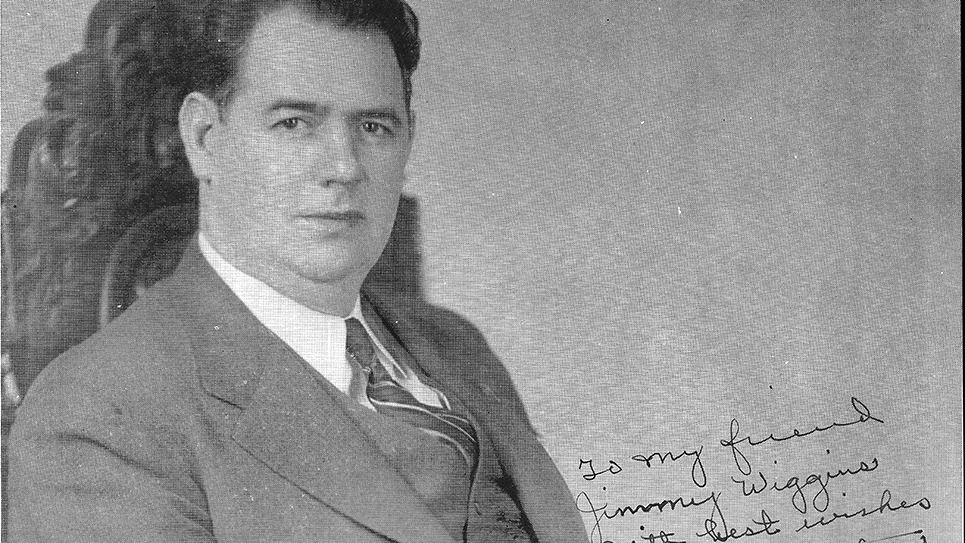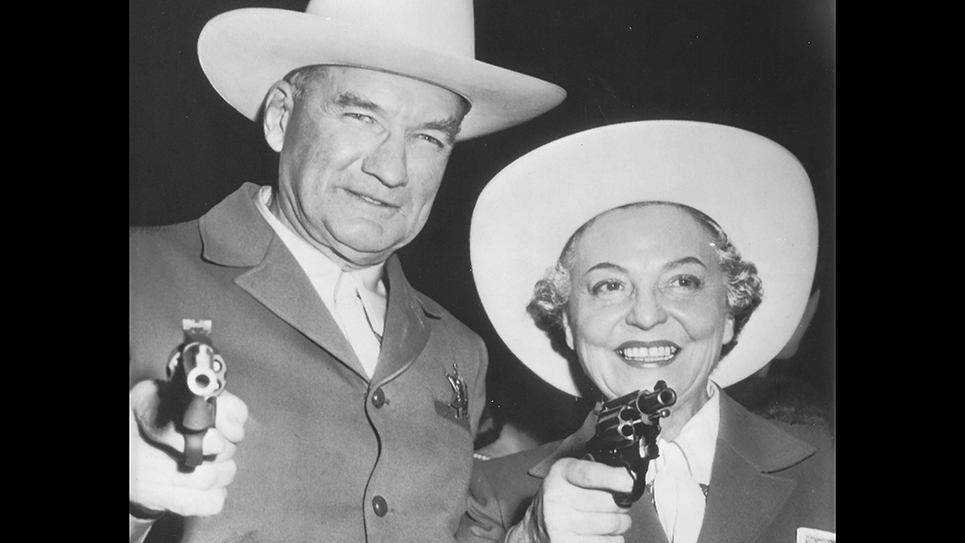The Friend of the Workers: Olin D. Johnston of South Carolina
By Ray Hill
Olin DeWitt Talmadge Johnston was a fixture in the politics of his native South Carolina for decades. Twice elected governor and elected to the United States Senate in 1944 where he remained until his death more than 20 years later, Johnston was one of the few statewide figures who was more liberal-minded on most matters, save for that of race. Olin Johnston was among the first Southerners who were outspoken in support of Social Security, as well as the government financing the medical care of the elderly. Johnston was also a proponent of developing public power to provide electricity for South Carolinians, an important issue in the Palmetto State. A staunch friend of the downtrodden and the working person, Johnston was perhaps the U.S. senator the most devoted to public employees who appreciated his constant push for better working conditions, pay and benefits on their behalf. Organized labor was a source of strong support for Olin Johnston in virtually every race he ran.
Much of Olin Johnston’s success as a politician was described by Governor Donald Russell, who said, “I have never known a warmer, more patient and steadfast friend than he. He was equally warm and gracious to all, the lowly and the mighty.”
Admirers referred to Olin Johnston as “South Carolina’s Roosevelt.” Johnston’s empathy for working people likely sprang from his own background and his never having forgotten where he came from. The Johnston family lived and worked on a farm while being employed by the Chiquola Manufacturing Company’s textile mill. Young Olin spent time working at the mill and doing farm chores. Johnston’s education was sporadic, but he eventually went to the Textile Industrial Institute, which later became Spartanburg Methodist College. A bright and successful student, Johnston completed his high school studies in just thirteen months before enrolling in Wofford College. Johnston paid his way through college by working a variety of jobs before he left school to enter the Army during the First World War. Johnston was a member of the 117th Engineering Unit, which was a part of the 42nd Division. Like Tennessee’s own Carroll Reece, Olin Johnston was part of the famed “Rainbow Division.” Once discharged from the Army, Johnston hurried home to South Carolina and completed his studies at Wofford College. After receiving a bachelor’s degree, Johnston entered the University of South Carolina where he earned a master’s degree in political science in 1923, followed by a law degree in 1924. Johnston began practicing law in Spartanburg and married Gladys Atkinson. For the remainder of his life, Johnston’s wife Gladys would be his most valued and trusted advisor.
Olin Johnston won his first election while still attending college, winning a seat in South Carolina’s House of Representatives in 1922. Johnston served only one term before choosing not to seek reelection to concentrate on his brand-new law practice. The 6-foot-4-inch Johnston proved to be an able campaigner and ran for the House of Representatives once again in 1926 and won. Johnston was reelected in 1928, serving Spartanburg County. It was during his career in the South Carolina state legislature Johnston won a reputation as the friend of the textile mill workers. Perhaps Olin Johnston’s most enduring accomplishment as a legislator was sponsoring and passing a bill requiring mill owners to install sewers in their mill villages.
Johnston saw bigger things for himself and, rather than running for the House of Representatives once again, he opted to enter the Democratic primary for governor in 1930. In a field of eight candidates, which included Congressman Asbury “Frank” Lever, Johnston demonstrated his popular appeal by coming in first with roughly a quarter of the ballots cast. South Carolina, like most Southern states, required a run-off election if no candidate received a majority. Johnston faced Ibra Charles Blackwood, who had accomplished the same feat as Johnston four years earlier. Blackwood had led the first primary, only to lose the run-off election. The bald and jowly Blackwood managed to scrape by Johnston in the run-off election by just 969 votes. As governor, Blackwood’s term of office was marred by a serious strike by textile mill workers. Governor Blackwood called out the National Guard, which set the table for Olin Johnston to run for governor once again in 1934.
Once again eight men entered the Democratic primary for the gubernatorial nomination and Johnston’s main opponent was Coleman Blease. At one time, Blease had been the political idol of South Carolina’s textile mill workers, including Olin Johnston. Blease’s popularity had gotten him elected both governor and U.S. senator, but he had been on a losing streak since his defeat in the 1930 Democratic primary when he lost his Senate seat to James F. Byrnes. An excellent stump speaker well able to rouse his audiences, Blease stumped all across the state, but it was Olin D. Johnston who ran first in the initial primary. Johnston led Blease by just over 19,000 votes in the first primary. In the run-off election, Johnston beat Blease by almost 35,000 votes to become the Democratic nominee. That was tantamount to election in South Carolina at the time.
At age 38, Olin Johnston became governor of South Carolina. Johnston was a strong backer of President Franklin D. Roosevelt, and his administration of South Carolina’s government was in the same spirit as that of the New Deal nationally. Johnston saw to it several bills were introduced in the legislature to improve the lot of textile mill workers in the state. Perhaps Johnston’s most notable achievement during his first term as governor was the elimination of the state property tax.
Prohibited from seeking a second consecutive term as governor in 1938, Johnston became the weapon with which President Roosevelt intended to bludgeon Senator E. D. Smith to political death inside the Democratic primary. “Cotton Ed” Smith had been a fixture inside the United States Senate for thirty years. It was not at all unusual for Smith to face a credible opponent inside the Democratic primary and the senator oftentimes won close contests, but win he always did. FDR was still angry with many of the Democrats in the United States Senate who had killed his proposal to expand the U.S. Supreme Court. “Cotton Ed” Smith, chairman of the Senate’s Agriculture Committee, had a number of bones to pick with the New Deal and made no secret of his disdain for the “brain trust” surrounding Roosevelt, which he ridiculed effectively. In spite of Smith’s seniority in the Senate, Smith had no power, but what he lacked in influence he made up for with his irrepressible personality and innate political showmanship. Johnston was a willing tool for Roosevelt’s attempt to avenge his defeat and announced his candidacy for the United States Senate from the White House, following a meeting with the president. Following a visit to South Carolina by Roosevelt where he obliquely was critical of “Cotton Ed,” even some supporters of the administration resented FDR’s interference in a state election. Using his penchant for invective, Smith labeled the governor “Machine Gun Olin” for having used force in his feud with the state highway commissioner. One prospective opponent, Edgar Brown, a leader of the notorious Barnwell Ring and longtime member of the South Carolina State Senate, routinely bragged if elected to the U.S. Senate, he would “bring home the bacon.” At the time, the rules of the Democratic Party in South Carolina required the candidates to make joint appearances in the state’s various counties. The 74-year-old Smith showed voters he was still spry and nimble enough to make an impression on the stump. Smith gave a withering dismissal of Brown, telling audiences, “I don’t doubt for a minute ‘Bacon’ Brown will bring home the bacon. The question is: whose smokehouse is he gonna put it in?” Edgar Brown dropped out of the race. “Cotton Ed” won the primary by over 36,000 votes, defeating Johnston decisively. Returning to the United States Senate, Smith was one of two senators who supposedly replied to someone who said Franklin Roosevelt was his own worst enemy by snapping, “Not while I am still alive!”
Johnston once again ran for the U.S. Senate in a 1941 special election after President Roosevelt had appointed James F. Byrnes to a seat on the U.S. Supreme Court. The Democratic primary was a three-way affair between the sitting governor, Burnet Maybank, Congressman Joseph R. Bryson and former Governor Olin D. Johnston. Maybank led in the first primary and won a bigger victory in the run-off election. A native of Charleston, Burnet Maybank won an astonishing 94% of the vote against Johnston in his home county.
Undeterred by his defeat, Olin Johnston entered the 1942 Democratic primary for the gubernatorial nomination. Johnston realized if he lost that election, he would quite likely be finished as a statewide candidate. The former governor won the nomination outright in the first primary and was unopposed in the general election. Olin Johnston had won a second nonconsecutive term as governor of South Carolina.
Still, Johnston’s desire to sit in the U.S. Senate had not left him and he challenged the 80-year-old “Cotton Ed” Smith in the 1944 Democratic primary. Smith was ailing and aged and ran an ineffective reelection campaign. The old senator could only muster around 35% of the vote, 20 percentage points behind Olin Johnston.
Olin Johnston had not run the most difficult race of his career. In 1950, Johnston was seeking a second term when Governor J. Strom Thurmond announced he was running for the United States Senate. It was one of the hardest-fought primaries South Carolina had ever seen; Thurmond had carried the Palmetto State in the 1948 election as the candidate of the States’ Rights Democratic Party over President Harry Truman. Johnston beat Thurmond, administering the only defeat of Thurmond’s long political career.
In 1962, Olin Johnston faced yet another sitting governor inside the Democratic primary. Ernest “Fritz” Hollings had been something of a “wunderkind” and was acknowledged as a progressive for the time. Hollings later paid tribute to Johnston’s popularity and skill as a campaigner. Senator Johnston carried every county in the state save for one. It was a humiliating and humbling defeat for Hollings.
After having fought his last great political battle in 1962, Senator Olin D. Johnston fought a more personal battle with cancer. Johnston had lost political skirmishes before, but the relentlessness of the cancer debilitated the old political warrior. Olin Johnston lay in Providence Hospital in Columbia, South Carolina, seriously ill following a second abdominal operation in less than three months. By Saturday, April 17, 1965, physicians for the 68-year-old senator issued a dire bulletin about Johnston’s status. The senator’s physician said Johnston was afflicted with viral pneumonia, was not responding to treatment, and had slipped into a “semi-comatose” state. The doctor said the senator’s condition was critical and death appeared to be imminent. Physicians had reportedly pumped fluid from his chest the preceding Friday night. A change of medication had allowed the senator to rest more comfortably. The senator’s closest friend and one of his most important political advisors was his brother, William. A worried Bill Johnston said, “The doctors are working tirelessly to pull him through.”
Death found U.S. Senator Olin D. Johnston at 4:21 a.m. on Easter Sunday, April 18, 1965. As Johnston breathed his last, sitting by his bedside were his wife, Gladys, two daughters, and two brothers. Several friends were waiting in the corridors of the hospital when they heard Johnston was slipping away. “I didn’t think he could hold on as long as he did,” one of the senator’s doctors said. “But he was a fighter. I guess that was the story of his whole life.”
Indeed, it was. Olin D. Johnston remained a fighter until the very end.
Olin Johnston’s daughter Liz Patterson was elected to Congress as a Democrat and served several terms before losing her seat in the House.
© 2023 Ray Hill







